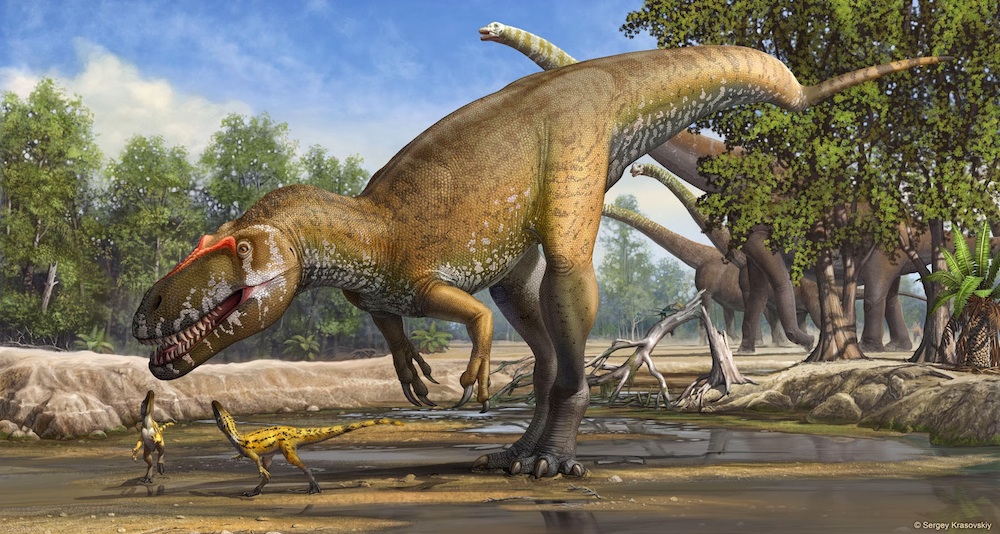
A massive, meat-eating dinosaur that roamed a Jurassic-era coastline has been unearthed in Portugal.
The big-clawed, sharp-toothed newly discovered species, dubbed Torvosaurus gurneyi, may be the largest land predator from the period ever found in Europe.
"It's a dinosaur that is quite similar to T. rex," with huge teeth and an elongated snout, said study co-author Christophe Hendrickx, a paleontology doctoral candidate at the Universidade Nova de Lisboa in Portugal. [See Images of the New Dinosaur Predator]
Dino-rich region
Lourinhã, Portugal, is a fossil-rich region where sheer cliffs overlook the shoreline. During the late Jurassic Period, the area boasted a vast, steamy river plain rich with lush vegetation and a diverse array of dinosaurs. Last year, scientists described several well-preserved dinosaur embryos in Lourinhã from the genus Torvosaurus but could not identify the species discovered at the site. [See Photos of the Dinosaur Embryos and Hatchlings]
The new dinosaur was first unearthed in 2003, when an amateur paleontologist uncovered part of a jawbone. A shinbone, teeth and fragments of tail vertebrae were also discovered later. Scientists initially thought the bones came from Torvosaurus tanneri, a massive land-based predator that lived in North America some 150 million years ago.
But Hendrickx and his colleague Octávio Mateus, a paleontologist also at the Universidade Nova de Lisboa, took a closer look at the skeletal remains and determined that they came from the newly named species.
Get the world’s most fascinating discoveries delivered straight to your inbox.
European behemoth
The European behemoth was a theropod, a suborder of meat-eating dinosaurs that includes the mighty Tyrannosaurus rex. Though T. gurneyi grew to 33 feet (10 meters) long and weighed 4 to 5 tons, it was still smaller than T. rex, which was 40 feet (12 m) from head to toe.
Its huge, bladelike, 4-inch-long (10 centimeters) teeth confirm the massive dinosaur was a carnivore, Hendrickx told Live Science.
"Most likely, it was a predator," Hendrickx said, and it probably hunted large, live prey, as there was a wide variety of herbivorous dinosaurs during that time. However, it may have also been a scavenger, he added.
Big creatures
The new discovery changes the picture of European dinosaurs at the time. Back then, Europe was an archipelago of large islands, and animals often evolve to be smaller on islands. In fact, many of the dinosaurs in the late Jurassic Period in Europe show signs of dwarfism, Hendrickx said. (The Jurassic lasted from 199.6 million to 145.5 million years ago.)
But when it came to size, Torvosaurus gurneyi could hold its own against the giant super predators of North America, showing that "large dinosaurs did exist in Europe by the end of the Jurassic," Hendrickx said.
The fossil discoveries also suggest that the dinosaur embryos discovered last year belonged to T. gurneyi, Hendrickx said.
The findings were published today (March 5) in the journal PLOS ONE.
Follow Tia Ghose on Twitter and Google+. Follow Live Science @livescience, Facebook & Google+. Original article on Live Science.

Tia is the editor-in-chief (premium) and was formerly managing editor and senior writer for Live Science. Her work has appeared in Scientific American, Wired.com, Science News and other outlets. She holds a master's degree in bioengineering from the University of Washington, a graduate certificate in science writing from UC Santa Cruz and a bachelor's degree in mechanical engineering from the University of Texas at Austin. Tia was part of a team at the Milwaukee Journal Sentinel that published the Empty Cradles series on preterm births, which won multiple awards, including the 2012 Casey Medal for Meritorious Journalism.


